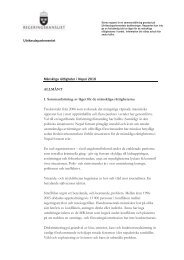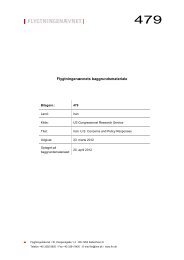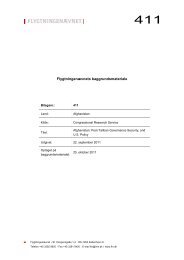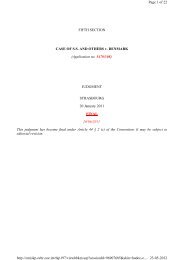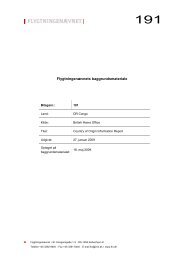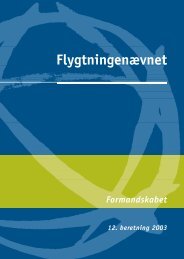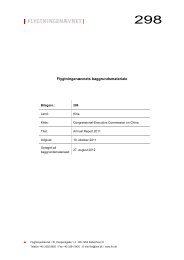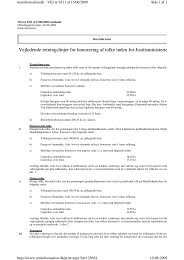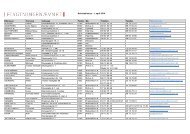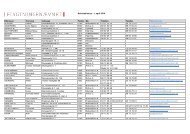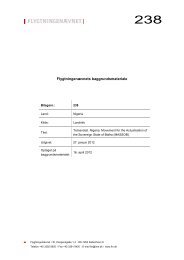Annual Report - National Human Rights Commission
Annual Report - National Human Rights Commission
Annual Report - National Human Rights Commission
You also want an ePaper? Increase the reach of your titles
YUMPU automatically turns print PDFs into web optimized ePapers that Google loves.
Annexure 12<br />
○ ○ ○ ○ ○ ○ ○ ○ ○ ○ ○ ○ ○ ○ ○ ○ ○ ○ ○ ○ ○ ○ ○ ○ ○ ○ ○ ○ ○ ○ ○ ○ ○ ○ ○ ○ ○ ○ ○ ○ ○ ○ ○ ○ ○ ○ ○ ○ ○ ○ ○ ○ ○ ○ ○ ○ ○ ○ ○ ○ ○<br />
○<br />
and certain NGOs carry out such programmes, they are microscopic, considering the scale of<br />
the problems concerned. The research has shown that there is a ‘conspiracy of silence’ by all<br />
concerned, which does not exclude family, community, religious institutions, political parties<br />
and, at times, even CBOs, NGOs. There is a need to have extensive and sustained awareness<br />
programmes focused on rights of individuals. Such programmes should be sustained too. It<br />
would be a good strategy to empower them by encouraging leaders from among them, who<br />
would be able to garner adequate public support for the anti-trafficking initiatives. Moreover,<br />
such awareness campaigns could be target-oriented, with specific attention on the most vulnerable<br />
sections of society.<br />
Sensitization of Adolescents<br />
This research has shown that a large number of the victims as well as clients are teenagers or<br />
adolescents, especially school and college students. There is a need to address the issue of sexuality<br />
within this group and sensitise them about the human rights of women and children. Appropriate<br />
NGOs could be asked by the educational institutions to carry out such target-oriented advocacy<br />
in schools, colleges, etc.<br />
Role of Family<br />
The study has shown that certain families, due to several reasons, are directly or indirectly involved<br />
in the trafficking process. It could be their ignorance, lack of livelihood options arising out of<br />
poverty, prevailing cultural traditions, or commercial motives. There are plenty of instances of<br />
family members getting lured by traffickers, falling prey to their evil designs and, thereupon,<br />
allowing their wards to be trafficked. All such acts of omission and commission have to be<br />
addressed. The situations vary from place to place and, therefore, intervention programmes have<br />
to be focused on the assessment of these realities. The mapping exercise stated earlier could be<br />
utilised for this assessment. Moreover, any preventive strategy should take the family into<br />
consideration, as the role of the family has been found crucial.<br />
Social Culture<br />
This research has brought to light the fact that prevention of trafficking is possible only if the<br />
community is fully involved. Trafficking has deep roots in the social ethos of the society and,<br />
therefore, cannot be handled by law alone. The larger issues of lack of livelihood options, gender<br />
discrimination and deprivation of opportunities have to be kept in mind. Therefore, any preventive<br />
strategy should focus on eradication of poverty, illiteracy, lack of awareness of rights and livelihood<br />
options, as well as on issues of social and economic empowerment. The lack of options provides<br />
a fertile ground for the exploiters to enhance their commercial motivation and grow rich faster.<br />
Therefore, the basic question is to uphold community values and create a culture against<br />
exploitation of women and children. Community should become a guarantor of human rights.<br />
The prevailing ‘culture of silence’ of the community has to be transformed into ‘community<br />
involvement’. In this context, besides the role of family discussed earlier, there is an important<br />
role to be played by all stakeholders, viz., the schools, the panchayats, other democratic institutions,<br />
<strong>National</strong> <strong>Human</strong> <strong>Rights</strong> <strong>Commission</strong> <strong>Annual</strong> <strong>Report</strong> - 2004-2005<br />
277<br />
AR-Chapter-1-19-10-6-06.p65<br />
297<br />
7/17/06, 6:31 PM



